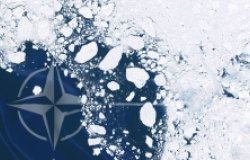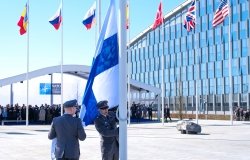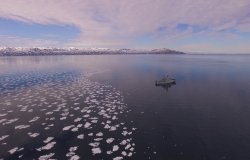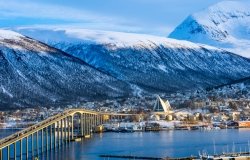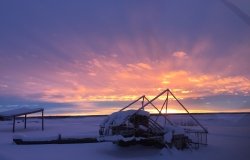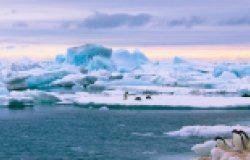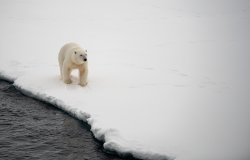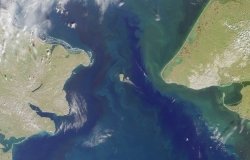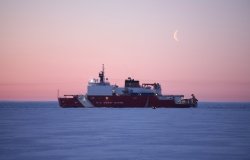
A blog of the Polar Institute
No. 9 | The Arctic Fisheries Agreement Enters into Force
David Balton is a Senior Fellow with the Wilson Center’s Polar Institute. He formerly served as the U.S. Ambassador for Oceans and Fisheries and, in that capacity, chaired the international negotiations that produced the Central Arctic Ocean Fisheries Agreement.
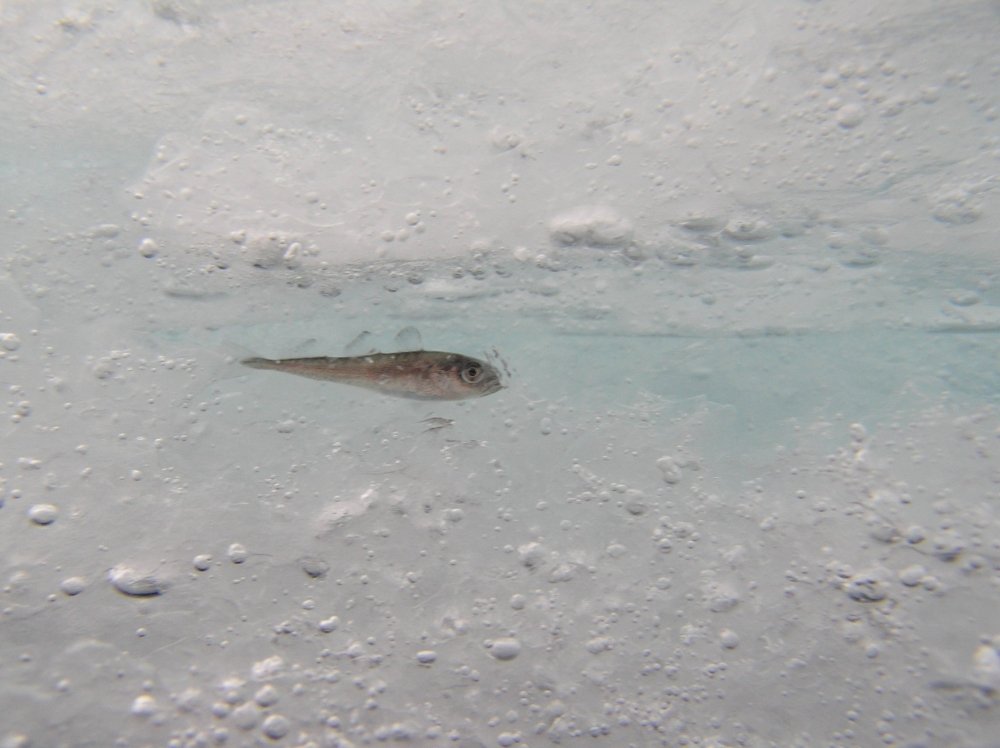
"expl0392" by Shawn Harper, Hidden Ocean 2005 Expedition: NOAA Office of Ocean Exploration (CC BY 2.0) / Flickr.com
The Central Arctic Ocean Fisheries Agreement (“the Agreement”)[1] entered into force today, bringing to fruition a U.S.-led diplomatic effort that began more than a decade ago. Nine States and the European Union have completed their internal approval procedures and deposited the requisite instruments with Canada, which serves as the depositary government.
The Agreement represents an unusual and farsighted effort to address a potentially serious environmental problem before the problem actually occurs. Too often, governments find themselves in the unenviable situation of dealing with such problems only after they have arisen. This time, they acted in advance to prevent the initiation of unregulated commercial fishing in a wide swath of the Arctic Ocean―fishing that could have caused significant harm to the marine environment.
The Parties to the Agreement are Canada, China, Denmark (in respect of Greenland and the Faroe Islands), the European Union, Iceland, Japan, Norway, Russia, South Korea and the United States. For the first time, a treaty relating specifically to the Arctic region includes non-Arctic adherents.
Overview of the Agreement
The Agreement, analyzed in detail in a number of previous articles,[2] creates two basic commitments. First, the Parties commit, for the duration of the Agreement, not to allow their vessels to conduct commercial fishing operations in the large high seas portion of the Central Arctic Ocean, shown in the hatched area of the map below.
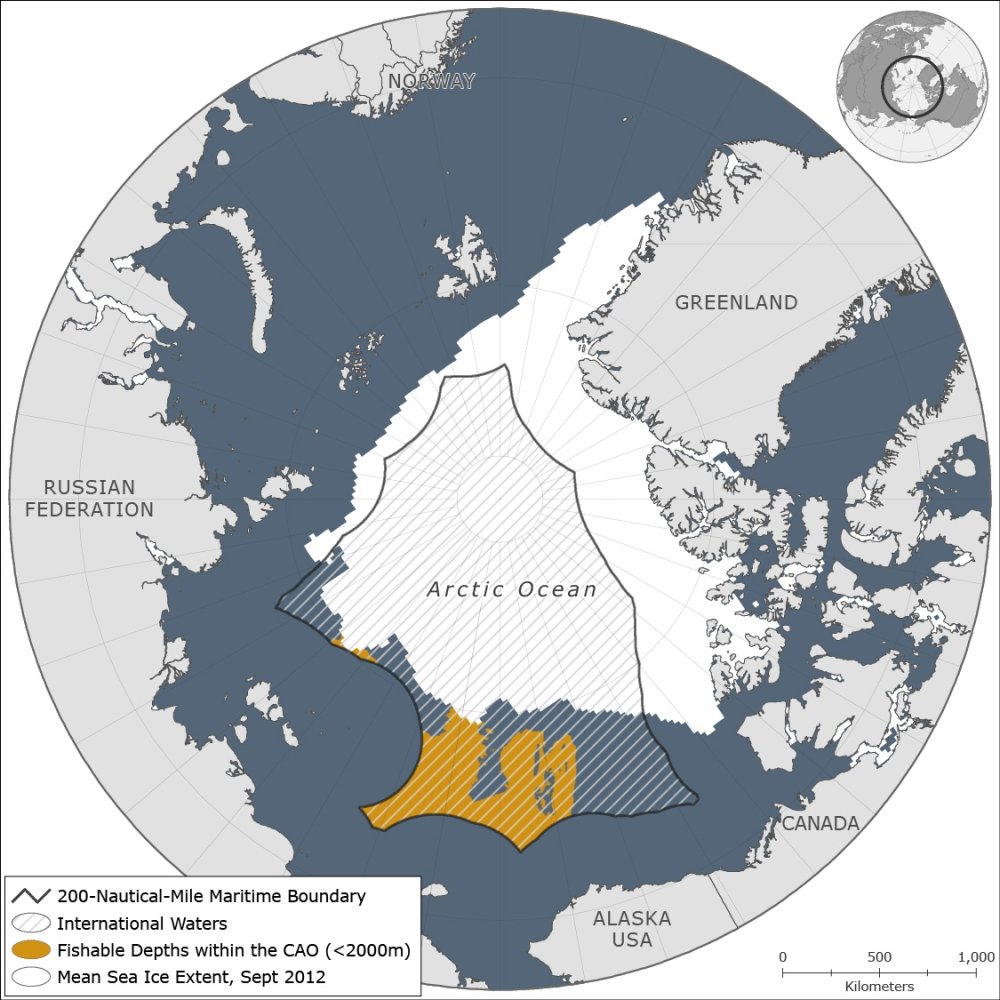
The Pew Charitable Trusts
No commercial fishing has ever taken place in this high seas area because ice has covered it since the beginning of human history. That is, until now. The Arctic is warming on average three times as fast as the Earth as a whole. As a consequence, a significant percentage of the Arctic Ocean, including some of the high seas area, is now ice-free for part of each year. Current projections indicate that the entire Arctic Ocean is likely to be ice-free for part of the year within a few decades.
Why would these governments agree not to allow commercial fishing in this large and increasingly accessible ocean space? They did so in large part because they do not know enough about the ecosystems of this part of the ocean to have any reliable basis on which to manage a commercial fishery there successfully, which is to say, sustainably. This facet of the Agreement gives effect to the “precautionary approach” as articulated in the 1992 Rio Declaration and later instruments[3]: in the face of scientific uncertainty, the Parties have taken a measure—the Agreement and the prohibition on commercial fishing embedded within it—to prevent the possibility of serious environmental degradation.
The second basic obligation of the Parties is to create a Joint Program of Scientific Research and Monitoring for the Central Arctic Ocean: "with the aim of improving their understanding of the ecosystems of the Agreement Area and, in particular, of determining whether fish stocks might exist in the Agreement Area now or in the future that could be harvested on a sustainable basis and the possible impacts of such fisheries on the ecosystems of the Agreement Area" (Agreement, Article 4).
If properly implemented, the Joint Program will fulfill at least two objectives. Most obviously, it will advance the state of knowledge of one of the least understood parts of the world ocean. The Joint Program will also give the Parties more data on which to make a critical determination sometime in the future, namely, whether to replace the Agreement with something different: a treaty that would create a mechanism through which to open and manage a sustainable commercial fishery on the basis of sound science.
The Agreement will remain in force for 16 years, and will be extended in five-year increments thereafter unless any Party objects. Like most other elements of the Agreement, this approach to its duration represents a compromise among different interests. Those Parties whose national fishery zones surround the high seas portion of the Central Arctic Ocean—Canada, Denmark (Greenland and the Faroe Islands), Norway, Russia and the United States—would have preferred to forestall the possibility of a high seas fishery even longer. The other Parties, particularly those from Asia and the European Union who have fleets seeking new opportunities to fish in high seas areas, would have preferred a shorter period in which the prohibition on such fishing remains in effect.
Those interested in further details about the provisions of the Agreement can find them in the articles referenced in footnote 2. But two related aspects deserve mention here: the Agreement requires the use of Indigenous and local knowledge in the Joint Program and related work, and it guarantees the participation of Arctic Indigenous peoples in the implementation of the Agreement.
In that connection, the Agreement recognizes that Arctic residents, including members of Arctic Indigenous communities, have significant interests in preventing unregulated fishing in the high seas portion of the Central Arctic Ocean. Even though the Indigenous people and others who live near the Arctic coastline do not engage in high seas fishing, the potential depletion of fish stocks in the high seas area by commercial fishing vessels would threaten marine resources closer to shore on which those communities depend. That is why three of the delegations involved in the negotiation of the Agreement—those of Canada, Denmark (Greenland and the Faroe Islands) and the United States—included representatives from Indigenous communities. Those individuals provided compelling perspectives and insights that would otherwise have not been considered, at least not fully.
Getting to Yes
As noted above, the Agreement had a gestation period of well over a decade. In 2008, the U.S. Congress passed a Joint Resolution, signed into law by President George W. Bush, that called for the negotiation of such an agreement. Soon thereafter, the United States adopted its first-ever Arctic Fisheries Management Plan, which essentially prohibited commercial fishing in the U.S. Exclusive Economic Zone north of Alaska—also because of a lack of scientific knowledge necessary to manage fisheries there successfully.
In parallel with these domestic developments, the United States began urging its immediate neighbors in the Arctic—Russia and Canada—to consider the possibility of an international agreement to prevent or delay commercial fishing in the high seas portion of the Central Arctic Ocean. Those discussions eventually broadened to include Norway and the Kingdom of Denmark as well.
Although it was far from clear that these other four governments would support the launching of negotiations on such an agreement—Russia, in particular, expressed significant doubts about the necessity or even the desirability of moving forward—the United States invited delegations from these States to a formal round of talks in Washington. After a few more meetings among these delegations, they reached agreement on a non-binding statement known as the Declaration Concerning the Prevention of Unregulated High Seas Fishing in the Central Arctic Ocean, signed in Oslo in 2015.
The Oslo Declaration recognized that, under international law, vessels from any State in principle have the right to fish on the high seas. Thus, a broader negotiating process would be necessary to prevent unregulated fishing in the high seas portion of the Central Arctic Ocean, one that would include other States, as well as the European Union, with fishing fleets potentially capable of fishing there. The larger group met six times over two years—three times in Washington and once each in Iqaluit, Torshavn and Reykjavik—before successfully concluding negotiations on the Agreement in November 2017. Greenland hosted a signing ceremony for the Agreement in October 2018.
Signing Ceremony in Ilulissat, Greenland, October 3, 2018
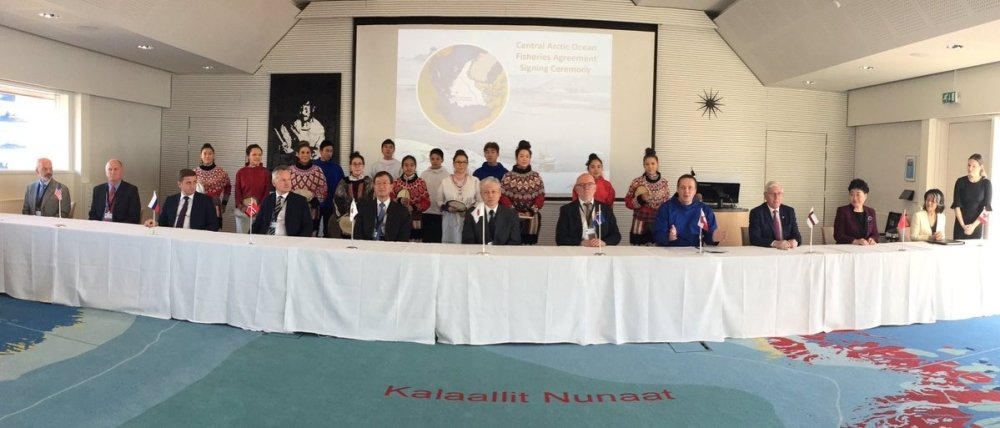
David Balton
The negotiating process benefited from remarkable engagement and support of various kinds among the environmental, scientific and academic communities. Peter Harrison and his co-authors captured many of these contributions in an article that the Wilson Center posted in 2020 entitled “How Non-Government Actors Helped the Arctic Fisheries Agreement.”
The engagement and support of these communities produced, among other things, a variety of international symposia to consider what (little) is known about the ecosystems of the Central Arctic Ocean, to develop a research agenda to enhance understanding of the area, and to build support for the proposition that there should be no commercial fishing in the area until much more is known.
The United States Government also invited scientists from other nations to examine these questions and to provide their advice to policymakers. That initial meeting grew into a series of five “Meetings of Scientific Experts on Fish Stocks in the Central Arctic Ocean” that ran alongside the diplomatic negotiations. The back-and-forth between the policymakers and scientists certainly made for a more informed negotiating process and, ultimately, a more robust Agreement.
Looking back over these events, one might be tempted to conclude that the development of the Agreement followed an obvious, even inevitable, path to completion. That was hardly the case. During the years in question, serious tensions arose between Russia and the other Arctic States over the situation in Syria as early as 2011, and especially over the invasion of Crimea in 2014. Evidence that Russia sought to influence the outcome of the 2016 U.S. election and the more recent revelations of Russia’s role in hacking U.S. Government computer systems made matters worse.
These and other sources of friction, including a souring of U.S.-Sino relations during the Trump Administration, threatened many times to derail the process to negotiate and sign the Agreement and to bring it into force. In the end, though, the governments in question chose to set aside those differences about other matters in favor of joining as partners in preventing unregulated commercial fishing in the Central Arctic Ocean, a matter of mutual interest. Russia, having repeatedly expressed misgivings about the negotiating process, became the first to ratify the Agreement. The United States and others followed in reasonably short order. China, after some delay, deposited its instrument in late May 2021, triggering the entry into force today, June 25, 2021.
More than once along the way, doubts also arose as to whether U.S. leadership of the negotiating process—launched in the waning days of the Bush Administration and pursued vigorously under President Obama—would continue following the election of President Trump. In fact, the approach of the U.S. Government in support of the Agreement hardly changed over the course of these three Administrations, and seems almost certain to continue under President Biden as well.
Next Steps
In anticipation of the Agreement’s entry into force, a number of preparatory meetings have already taken place among the governments in question, most recently on a virtual basis earlier this month. The agendas for these meetings have included the development of rules of procedure for the formal Meetings of the Parties following entry into force, consideration of a science body to advise the Parties on the Joint Program and related issues, questions concerning Indigenous knowledge and the participation of Indigenous communities in the ongoing work, and other topics.
The governments now need to decide when and where to hold the first Meeting of the Parties, a question complicated by the pandemic. While this gathering could theoretically take place virtually, in practice only an in-person event would allow for the careful negotiation of decisions necessary to begin successful implementation of the Agreement. For that reason, the first Meeting probably will not occur until 2022, when an in-person meeting of this nature may become feasible.
For the first Meeting of the Parties, governments will need to select a chair, who may (or may not) be from the hosting Party. At the first Meeting, it should be possible to adopt the rules of procedure, establish a science body and possibly create other subsidiary entities. The Agreement requires the Parties to establish the Joint Program within two years of entry into force; at the first Meeting, they will have the opportunity to take additional steps to ensure that the Joint Program will be up and running by that time.
Perhaps the most interesting, and potentially sensitive, matters concern Indigenous issues. The Agreement is one of the first—if not the very first—treaty to require the use of Indigenous knowledge and to guarantee the participation of the Indigenous representatives in its implementation. The details concerning how to give effect to these commitments remain to be decided, however.
The Inuit Circumpolar Council (ICC) led a series of workshops on Inuit engagement in the Agreement in 2020 and 2021. The ICC and possibly other groups representing Arctic Indigenous peoples will have the opportunity to propose ways forward, which the governments would do well to review favorably. The governments would also do well to consider recommendations put forward by Betsy Baker in another piece that the Wilson Center recently published, entitled “Smart as SILK: An Innovative Advisory Body for Implementing the Knowledge-based Requirements of the Central Arctic Ocean Fisheries Agreement.”
Conclusion
On one level, the Arctic Fisheries Agreement deals with a non-emergency situation in a part of the world that most people rarely consider. On another level, the Agreement is remarkable, embodying a number of noteworthy achievements.
From a U.S. perspective, the effort to develop the Agreement represents an unusual coalescing of interests. As the idea for the Agreement began to take shape, U.S. Government consultations among representatives from the State of Alaska, the Alaska congressional delegation, the North Pacific Fisheries Management Council, the relevant part of the U.S. fishing industry, Alaska Native communities, the U.S. environmental community and U.S. scientific groups revealed support for the same basic approach among all of them (perhaps a first in the history of international fisheries issues involving the United States). That confluence of interests largely explains why U.S. Government policy in advancing the Agreement remained consistent across two Republican and two Democratic Administrations.
From an international perspective, the Agreement demonstrates that nations can find ways to act in their mutual self-interest even in the face of serious geopolitical tensions. The sources of friction involving Russia and China noted above, including recent concerns relating to Chinese involvement in the Arctic, might have doomed the Agreement, particularly during the Trump Administration. But the United States, Russia and China—along with the other governments in question—decided to sign and ratify the Agreement and will now join in giving effect to this new and groundbreaking multilateral instrument.
David Balton, speaking about the Agreement at the Arctic Circle Assembly in 2017
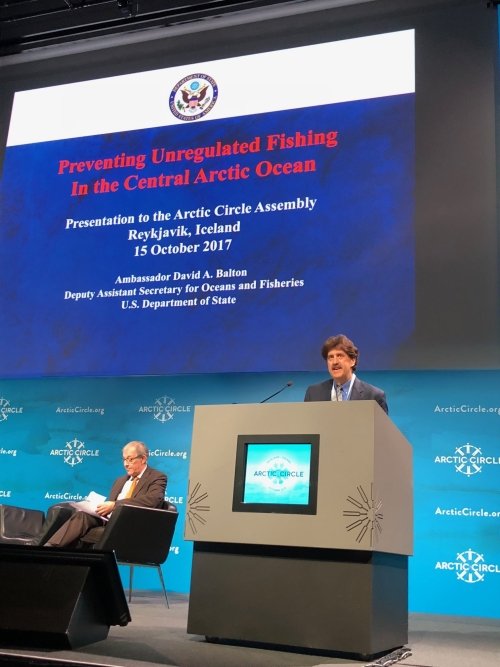
David Balton
[1] The full title of this treaty is the Agreement to Prevent Unregulated High Seas Fisheries in the Central Arctic Ocean.
[2] See, e.g., Balton, D., Implementing the New Arctic Fisheries Agreement, in Heidar (ed.), New Knowledge and Changing Circumstances in the Law of the Sea (Brill) (2020); Balton, D. 2018, The Arctic Fisheries Agreement: Looking to 2030 and Beyond, in Correll et al. (eds.), The Arctic in World Affairs, A North Pacific Dialogue on Arctic 2030 and Beyond–Pathways to the Future, Korea Maritime Institute, East-West Center; Molenaar, E., The CAOF Agreement: Key Issues of International Fisheries Law, in Heidar (ed.) New Knowledge and Changing Circumstances in the Law of the Sea, 446–476 (Brill) (2020); Schatz, V., A. Proelss & N. Liu, The 2018 Agreement to Prevent Unregulated High Seas Fisheries in the Central Arctic Ocean: a Critical Analysis, International Journal of Marine and Coastal Law 34 (2)(2019); Rayfuse, R., The role of Law in the Regulation of Fishing Activities in the Central Arctic Ocean, Marine Policy 110 (2019); Serdy, A. “The Agreement to Prevent Unregulated High Seas Fisheries in the Central Arctic Ocean: An Overview,” Ocean Yearbook 33 (2019); Morishita, J., The Arctic Five-Plus-Five Process on Central Arctic Ocean Fisheries Negotiations, Reflecting the Interests of Arctic and Non-Arctic Actors, in: A. Shibata et al. (eds.), Emerging Legal Orders in the Arctic (2019); Vyleghzhanin, A., Young, O., and Berkman, P., The Central Arctic Ocean Fisheries Agreement as an Element in the Evolving Arctic Ocean Governing Complex, https://www.sciencedirect.com/science/article/pii/S0308597X20301780 (2020).
[3] Rio Declaration on Environment and Development, U.N. Doc. A/CONF.151/26/Vol.1 (June 1992). See also The United Nations Agreement for the Implementation of the Provisions of the United Nations Convention on the Law of the Sea of 10 December 1982 Relating to the Conservation and Management of Straddling Fish Stocks and Highly Migratory Fish Stocks, adopted in 1995 and entered in force 11 December 2001, U.N. Doc. A/CONF.164/37.
About the Author

Ambassador David Balton

Polar Institute
Since its inception in 2017, the Polar Institute has become a premier forum for discussion and policy analysis of Arctic and Antarctic issues, and is known in Washington, DC and elsewhere as the Arctic Public Square. The Institute holistically studies the central policy issues facing these regions—with an emphasis on Arctic governance, climate change, economic development, scientific research, security, and Indigenous communities—and communicates trusted analysis to policymakers and other stakeholders. Read more
